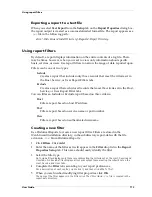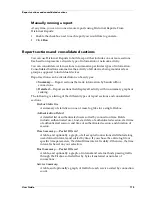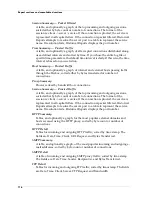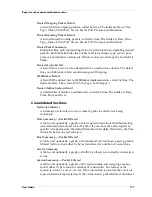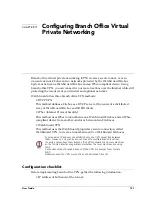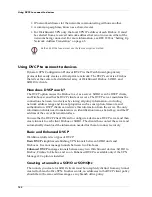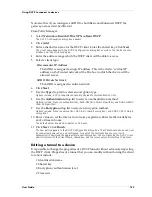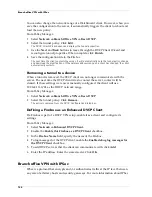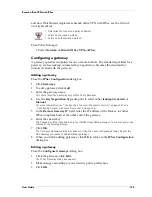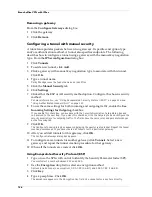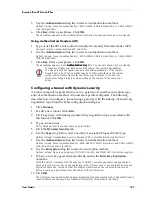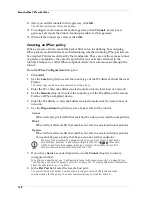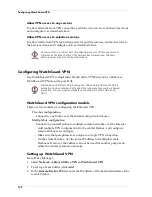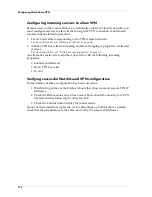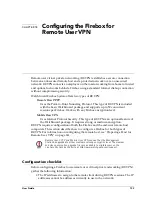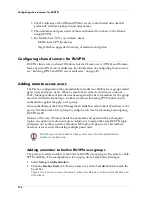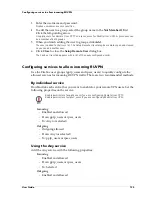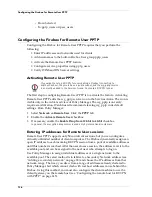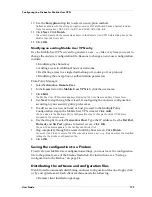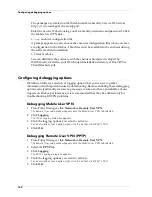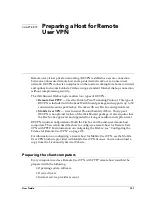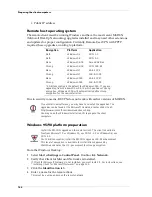
User Guide
127
Branch office VPN with IPSec
5
Use the
Authentication
drop list to select an authentication method.
Options include: None (no authentication), MD5-HMAC (128-bit algorithm), or SHA1-HMAC
(160-bit algorithm).
6
Click
Key
. Enter a passphrase. Click
OK
.
The passphrase appears in the Authentication Key field. You cannot enter a key here directly.
Using Authenticated Headers (AH)
1
Type or use the SPI scroll control to identify the Security Parameter Index (SPI).
You must select a number between 257 and 1023.
2
Use the
Authentication
drop list to select an authentication method.
Options include: None (no authentication), MD5-HMAC (128-bit algorithm), or SHA1-HMAC
(160-bit algorithm).
3
Click
Key
. Enter a passphrase. Click
OK
.
The passphrase appears in the Authentication Key
Authentication Key
Authentication Key
Authentication Key field. You cannot enter a key here directly.
Configuring a tunnel with dynamic security
A tunnel encapsulates packets between two gateways. It specifies encryption type
and/or authentication method. A tunnel also specifies endpoints. The following
describes how to configure a tunnel using a gateway with the isakmp (dynamic) key
negotiation type. From the IPSec configuration dialog box:
1
Click
Tunnels
.
2
To add a new tunnel, click
Add
.
3
Click a gateway with isakmp (dynamic) key negotiation type to associate with
this tunnel. Click
OK
.
4
Type a tunnel name.
Policy Manager uses the tunnel name as an identifier.
5
Click the
Dynamic Security
tab.
6
Use the
Type
drop list to select a Security Association Proposal (SAP) type.
Options include: Encapsulated Security Payload (ESP) or Authenticated Headers (AH).
7
Use the
Authentication
drop list to select an authentication method.
Options include: None (no authentication), MD5-HMAC (128-bit algorithm), and SHA1-HMAC
(160-bit authentication algorithm).
8
Use the
Encryption
drop list to select an encryption method.
Options include: None (no encryption), DES-CBC (56-bit), and 3DES-CBC (168-bit encryption).
9
To have a new key generated periodically, enable the
Force Key Expiration
checkbox.
With this option, transparent to the user, the ISAKMP controller generates and negotiates a
new key for the session. For no key expiration, enter 0 (zero) here. If you enable the Force key
expiration checkbox, set the number of kilobytes transferred or hours passed in the session
before a new key is generated for continuation of the VPN session.
10 Click
OK
.
The Configure Tunnels dialog box appears displaying the newly created tunnel. Repeat the tunnel
creation procedure until you have created all tunnels for this particular gateway.
If there are Fireboxes at both ends of the tunnel, the remote administrator
can also enter the encryption and authentication passphrases. If the remote
firewall host is an IPSec-compliant device of other manufacture, the remote
system administrator must enter the literal keys displayed in the Security
Association Setup dialog box when setting up the remote IPSec-compliant
device.
Содержание Firebox FireboxTM System 4.6
Страница 1: ...WatchGuard Firebox System User Guide Firebox System 4 6 ...
Страница 16: ...6 ...
Страница 20: ...LiveSecurity broadcasts 10 ...
Страница 44: ...LiveSecurity Event Processor 34 ...
Страница 52: ...Defining a Firebox as a DHCP server 42 ...
Страница 68: ...Service precedence 58 ...
Страница 78: ...Configuring a service for incoming static NAT 68 ...
Страница 92: ...Establishing an OOB connection 82 ...
Страница 94: ...84 ...
Страница 112: ...HostWatch 102 ...
Страница 118: ...Working with log files 108 ...
Страница 130: ...120 ...
Страница 158: ...Configuring debugging options 148 ...

